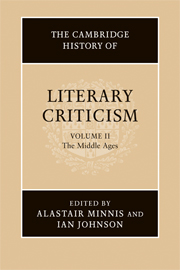Book contents
- Frontmatter
- Introduction
- I THE LIBERAL ARTS AND THE ARTS OF LATIN TEXTUALITY
- 1 Grammatica and literary theory
- 2 The arts of poetry and prose
- 3 The arts of letter-writing
- 4 The arts of preaching
- II THE STUDY OF CLASSICAL AUTHORS
- III TEXTUAL PSYCHOLOGIES: IMAGINATION, MEMORY, PLEASURE
- IV VERNACULAR CRITICAL TRADITIONS: THE EARLY MIDDLE AGES
- V VERNACULAR CRITICAL TRADITIONS: THE LATE MIDDLE AGES
- VI LATIN AND VERNACULAR IN ITALIAN LITERARY THEORY
- VII BYZANTINE LITERARY THEORY AND CRITICISM
- Bibliography
- Index
- References
1 - Grammatica and literary theory
from I - THE LIBERAL ARTS AND THE ARTS OF LATIN TEXTUALITY
Published online by Cambridge University Press: 28 March 2008
- Frontmatter
- Introduction
- I THE LIBERAL ARTS AND THE ARTS OF LATIN TEXTUALITY
- 1 Grammatica and literary theory
- 2 The arts of poetry and prose
- 3 The arts of letter-writing
- 4 The arts of preaching
- II THE STUDY OF CLASSICAL AUTHORS
- III TEXTUAL PSYCHOLOGIES: IMAGINATION, MEMORY, PLEASURE
- IV VERNACULAR CRITICAL TRADITIONS: THE EARLY MIDDLE AGES
- V VERNACULAR CRITICAL TRADITIONS: THE LATE MIDDLE AGES
- VI LATIN AND VERNACULAR IN ITALIAN LITERARY THEORY
- VII BYZANTINE LITERARY THEORY AND CRITICISM
- Bibliography
- Index
- References
Summary
No single medieval discipline embraced all that we call literary criticism or theory today, but the discipline closest to literary criticism – in the sense of the interpretation of a traditional literary canon and the description of literary language – was grammatica. The scope and cultural effects of grammatica are large topics, embracing literacy, linguistic theory, traditions of commentary and exegesis, and the development of a literary canon, but here we must limit the field to those aspects of grammatica that had a direct bearing on the practice of literary criticism and interpretation.
Grammatica was traditionally defined as having two main methodological divisions and subject-areas: ‘the science of interpreting the poets and other writers and the systematic principles [ratio] for speaking and writing correctly’, that is, the methods for reading, interpreting and evaluating literary works, especially the canon of classical poets, and the rules or principles for speaking and writing according to normative Latin conventions. The literary division of the discipline, scientia interpretandi, was understood to have four main parts or methodological divisions – lectio, the principles for reading a text aloud from a manuscript, including the rules of prosody; enarratio, exposition of content and the principles for interpretation, including the analysis of figurative language; emendatio, the rules for establishing textual authenticity and linguistic correctness, and iudicium, criticism or evaluation of writings. In the linguistic division, the object of analysis was the language of classical literary texts, the auctores, not ordinary speech. From its beginnings, then, grammatica was a science of the text, embracing a systematic description of the authoritative textual language (Greek or Latin) and the methods for reading and interpreting an established literary canon.
- Type
- Chapter
- Information
- The Cambridge History of Literary Criticism , pp. 13 - 41Publisher: Cambridge University PressPrint publication year: 2005
References
- 2
- Cited by

